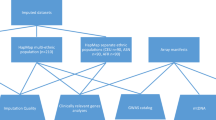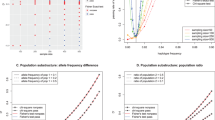ABSTRACT
A practical limitation to the identification of genetic profiles predictive of drug-induced adverse events is the number of patients with the adverse event that can be tolerated before the drug is withdrawn. Whole genome screening for regions of linkage disequilibrium (LD) associated with a particular phenotype may provide the mechanism to rapidly discover specific and sensitive profiles. We have used data from a large phase III clinical trial of tranilast and typed 76 SNPs over a 2.7 megabase region flanking the uridine diphosphate glucuronosyltranserferase 1A1 gene. Three SNPs within one LD block showed strong association with tranilast-induced hyperbilirubinemia (P<10−13). Our data illustrated that a genome-wide LD scan of 100 000–200 000 SNPs is sufficient to identify a pharmacogenetic association with a drug-induced adverse event.
This is a preview of subscription content, access via your institution
Access options
Subscribe to this journal
Receive 6 print issues and online access
$259.00 per year
only $43.17 per issue
Buy this article
- Purchase on Springer Link
- Instant access to full article PDF
Prices may be subject to local taxes which are calculated during checkout


Similar content being viewed by others
Abbreviations
- AE:
-
adverse event
- LD:
-
linkage disequilibrium
- SNP:
-
single-nucleotide polymorphism
- UGT1A1:
-
uridine diphosphate glucuronosyltranserferase 1A1
References
Carlson CS, Newman TL, Nickerson DA . SNPing in the human genome. Curr Opin Chem Biol 2001; 5: 78–85.
Dawson E, Abecasis GR, Bumpstead S, Chen Y, Hunt S, Beare DM et al. A first-generation linkage disequilibrium map of human chromosome 22. Nature 2002; 418: 544–548.
Kruglyak L . Prospects for whole-genome linkage disequilibrium mapping of common disease genes. Nat Genet 1999; 22: 139–144.
Lai E, Bowman C, Bansal A, Hughes A, Mosteller M, Roses AD . Medical applications of haplotype-based SNP maps: learning to walk before we run. Nat Genet 2002; 32: 353.
Goldstein DB, Ahmadi KR, Weale ME, Wood NW . Genome scans and candidate gene approaches in the study of common diseases and variable drug responses. Trends Genet 2003; 19: 615–622.
Lai E, Riley J, Purvis I, Roses A . A 4-Mb high-density single nucleotide polymorphism-based map around human APOE. Genomics 1998; 54: 31–38.
Phillips MS, Lawrence R, Sachidanandam R, Morris AP, Balding DJ, Donaldson MA et al. Chromosome-wide distribution of haplotype blocks and the role of recombination hot spots. Nat Genet 2003; 33: 382–387.
Couzin J . Human genome. HapMap launched with pledges of $100 million. Science 2002; 298: 941–942.
Cardon LR, Abecasis GR . Using haplotype blocks to map human complex trait loci. Trends Genet 2003; 19: 135–140.
Danoff TM, Campbell DA, McCarthy LC, Lewis KF, Repasch MH, Saunders AM et al. A Gilbert's syndrome UGT1A1 variant confers susceptibility to tranilast-induced hyperbilirubinemia. Pharmacogenomics J 2004; 4: 49–53.
Holmes Jr DR, Savage M, LaBlanche JM, Grip L, Serruys PW, Fitzgerald P et al. Results of Prevention of REStenosis with Tranilast and its Outcomes (PRESTO) trial. Circulation 2002; 106: 1243–1250.
Roses AD . Genome-based pharmacogenetics and the pharmaceutical industry. Nat Rev 2002; Drug Discov. 1: 541–549.
Hetherington S, Hughes AR, Mosteller M, Shortino D, Baker KL, Spreen W et al. Genetic variations in HLA-B region and hypersensitivity reactions to abacavir. Lancet 2002; 359: 1121–1122.
Arranz MJ, Collier DA, Munro J, Sham P, Kirov G, Sodhi M et al. Analysis of a structural polymorphism in the 5-HT2A receptor and clinical response to clozapine. Neurosci Lett 1996; 217: 177–178.
Goldstein DB, Tate SK, Sisodiya SM . Pharmacogenetics goes genomic. Nat Rev Genet 2003; 4: 937–947.
Masellis M, Basile V, Meltzer HY, Lieberman JA, Sevy S, Macciardi FM et al. Serotonin subtype 2 receptor genes and clinical response to clozapine in schizophrenia patients. Neuropsychopharmacology 1998; 19: 123–132.
Murphy Jr GM, Kremer C, Rodrigues HE, Schatzberg AF . Pharmacogenetics of antidepressant medication intolerance. Am J Psychiatry 2003; 160: 1830–1835.
Meng Z, Zaykin DV, Xu CF, Wagner M, Ehm MG . Selection of genetic markers for association analyses, using linkage disequilibrium and haplotypes. Am J Hum Genet 2003; 73: 115–130.
Schork NJ, Nath SK, Fallin D, Chakravarti A . Linkage disequilibrium analysis of biallelic DNA markers, human quantitative trait loci, and threshold-defined case and control subjects. Am J Hum Genet 2000; 67: 1208–1218.
Bowman C, Classification Using SNP Profiles Royal Statistical Society: Leuven, Belgium 2003; Statistical Genetics and Bioinformatics, July 14–17.
Holmes D, Fitzgerald P, Goldberg S, LaBlanche J, Lincoff AM, Savage M et al. The PRESTO (Prevention of restenosis with tranilast and its outcomes) protocol: a double-blind, placebo-controlled trial. Am Heart J 2000; 139: 23–31.
SAS. SAS Release 8. SAS Institute: Cary, NC 2000.
Mehta C, Patel N . A network algorithm for performing Fisher's exact test in r × c contingency tables. J Am Stat Assoc 1983; 78: 427–434.
Lewontin R . The interaction of selection and linkage. I. General considerations; heterotic models. Genetics 1964; 49: 49–67.
Weir BS . Disequilibrium. Genetic Data Analysis II. Sinauer Associates Inc.: Sunderland, MA 1996: 137.
Acknowledgements
We thank all the scientists within Discovery Genetics, GlaxoSmithKline for their scientific contributions. In addition, we would like to thank Pete Boyd and Aruna Basal for statistical advice and critical reading of the manuscript, and Mike Barnes for SNP mapping assistance. This study is wholly funded by GSK Research and Development.
Author information
Authors and Affiliations
Corresponding author
Additional information
DUALITY OF INTEREST
None declared.
Supplementary Information accompanies the paper on The Pharmacogenomics Journal website http://www.nature.com/tpj)
Supplementary information
Rights and permissions
About this article
Cite this article
Xu, CF., Lewis, K., Yeo, A. et al. Identification of a pharmacogenetic effect by linkage disequilibrium mapping. Pharmacogenomics J 4, 374–378 (2004). https://doi.org/10.1038/sj.tpj.6500268
Received:
Revised:
Accepted:
Published:
Issue Date:
DOI: https://doi.org/10.1038/sj.tpj.6500268
Keywords
This article is cited by
-
Japan Pharmacogenomics Data Science Consortium Database and Its Application for Drug Safety Analyses
Current Dermatology Reports (2016)
-
Complex disease-associated pharmacogenetics: drug efficacy, drug safety, and confirmation of a pathogenetic hypothesis (Alzheimer's disease)
The Pharmacogenomics Journal (2007)
-
Stepwise haplotype analysis: Are LD patterns repeatable?
Human Genomics (2006)
-
Comparative genomics analysis of human sequence variation in the UGT1A gene cluster
The Pharmacogenomics Journal (2006)
-
Pharmacogenetics and drug development: the path to safer and more effective drugs
Nature Reviews Genetics (2004)



